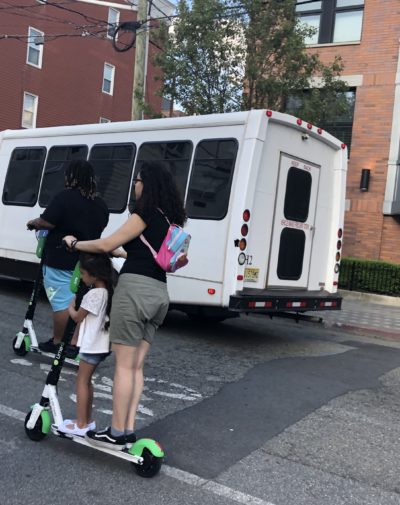
LIME WEDGE: Divided Over Scooters, Hoboken Needs To Get It Together — EDITORIAL
by Christopher Halleron
In Hoboken, we’re consistently reminded that we can’t have nice things. Whether it’s something as simple as clean sidewalks or something as good-natured as a traditional cultural parade, there’s just something in the nature of Hoboken that makes these things entirely too difficult to achieve.
The latest harrumphing point to come skidding onto the Hoboken scene is the City’s introduction of e-scooters. As is so often the case with these issues, it’s the reckless behavior of others that threatens to bring the whole thing to a screeching halt.
Hoboken had been flirting with the idea of scooters since at least August 2018 (see below). Nine months later, when the program eventually hit the streets, it was immediately obvious that the plan hadn’t fully gestated.
Come join me on @pier13hoboken tonight as we test drive electric-scooters From @limebike — a ride share that, with your support, can become part of our city’s arsenal, helping residents get around Hoboken with ease and with style. I’ll be here until 8:30, let’s ride #Hoboken! pic.twitter.com/1fMMdTMpl4
— Councilman Mike DeFusco (@mike_defusco) August 6, 2018
Hoboken’s City Council passed an ordinance in April 2019 that gave the go-ahead for six-month pilot program with Lime & Ojo, to provide electric scooters for rental by residents and visitors—thereby making it one of the first cities in the Tri-State area to officially launch an electric scooter sharing program.
“I am thrilled Hoboken is leading the way for the rest of the state to implement an additional mode of green transportation,” said Mayor Ravi S. Bhalla. “Electric scooters will help residents easily travel around our city, reduce congestion on our roadways, and improve access to transit stations and business districts. This is another way Hoboken is leading the way in implementing environmentally responsible transportation initiatives.”
Residential response ranged from completely stoked to absolutely terrified, as people weighed the benefits of the program against the inevitable stupidity that would come with it. Like the famed Springfield Monorail, a good number of skeptical Hobokenites saw scooters as more of a Shelbyville idea—wondering if the City had been hoodwinked, given the considerable vocal opposition to scooters in other markets. When the program became active on May 20, that vocal opposition instantly wove itself into the Hoboken social fabric.
In a word, the rollout of Hoboken’s scooter program was… troubled.
Social media was ablaze with evidence and anecdotes of demonstrable recklessness—underage riders, tandem riders, riders on sidewalks, wipeouts, collisions with vehicles, collisions with pedestrians, and the general sense of abhorrent behavior. Hoboken Police dealt with nearly 1,000 scooter-related complaints, comments and questions within the first 24 hours alone. And it hasn’t stopped since.
There are two basic camps to the debate. On one hand, the Four Horsemen of the Apocalypse are now riding scooters through Hoboken. On the other hand, it’s really fun so shut up and get back on your lawn old man. There are variations on the spectrum between the histrionics and hair-brained, and each side manages to have at least some merit.
Nevertheless, the numbers showed that these scooters are a massive hit. In a mere 12 hours, there were over 2,500 rides logged by 1,700 individual users. Within a month, Hoboken had seen more than 27,000 unique riders have taken nearly 100,000 rides—the highest ridership per scooter in Lime’s markets around the world.
With Lime squeezing a hell of a lot of juice out of Hoboken, many began to wonder why it wasn’t doing more to maintain its revenue stream. With scores of markets worldwide, the San Francisco-based “mobility” company was no stranger to the complexities of its product. Although it was already operating here in New Jersey, Hoboken’s population density presented challenges they weren’t seeing in smaller markets like Keyport and Plainfield. The denser the population, the higher probability your population is “dense.” In addition to Hoboken residents, there’s also significant tourist traffic to take into account.

Nope…
All that said, injuries from the scooters themselves were an issue everywhere—underscored by a fatality in Nashville the day before Hoboken rolled out its program.
As for the Hoboken Police Department, they’ve been learning to cope with an issue that was pretty much thrust upon them.
“We are doing enforcement gradually, we will continue to increase it,” said Police Chief Ken Ferrante, “however, every police officer is not going to jam on their breaks or start running after e-scooters that are being operated in violation. Would we do that for pedestrians, bicyclists, or cars or motorcycles? That would cause tunnel vision which would take away from the excellent violent crime numbers and apprehension statistics we have.”
When asked what scooter companies could do to alleviate the problem, Ferrante said, “I will be asking the companies to step up their monitoring of underage operation which is the most egregious and dangerous act I see so far.
With the pressure building, Lime has in fact taken significant steps to try to reel in Hoboken riders. They’re removing users from the platform for illegal behavior, including riding on sidewalks, running red lights and underage riding. Meanwhile Lime’s new scooter training course, First Ride Academy, teaches riders the proper way to ride a scooter in Hoboken. Too little too late for a 35 year-old man on a scooter who hit a pedestrian and attempted to flee the scene, only to be caught by Hoboken Police blocks away and become the city’s first arrest for a scooter-related violation.
As for Hoboken-specific solutions, Lime has called upon its own technology to create a slow-zone in the densely packed area along the city’s scenic Waterfront.
We have created an 8 MPH slow-zone on the #Hoboken waterfront from the North End to Pier A. Have fun and be safe! @CityofHoboken @HobokenPD pic.twitter.com/0Q2Q1Rgr5w
— Lime_NJ (@Lime_NJ) July 3, 2019
Of course hindsight is 20/20, but it’s worth wondering aloud why these fairly obvious concerns weren’t addressed before the launch. In the race to be “first” in our region, Hoboken didn’t have any laws on the books to cover scooter violations. It seemed as if the City just dumped these things onto the streets and were waiting for Darwinism to sort it out. “It’s a pilot program,” was the gist of the initial response.
As finger-pointing hit a crescendo among local politicians, Mayor Bhalla asked the Hoboken City Council to consider authorizing a public, non-binding question on the ballot in November. The resolution was voted down by a margin of 5-2.
That’s because Hoboken probably doesn’t really need another wedge issue. In a perilously divisive, sometimes dysfunctional political landscape, there’s already plenty to bicker about—particularly with a municipal election looming. If Hoboken wants to claim to be a leader “in implementing environmentally responsible transportation initiatives,” then it needs to lace up its low-top canvas sneakers and lead.

In recent years, some might argue that Hoboken has turned into a squeaky wheel republic, where the loudest, most antagonistic voices are the ones dictating policy. That’s not always the best way to move forward. Municipal leadership needs to listen to a variety of voices, recognizing benefits while giving credence to legitimate concerns, and come up with a blueprint for the future. Some of those choices may be hard to make—meaning they may be politically inconvenient in the short term. But part of being a leader is recognizing the long-term importance of what you’re doing, and having the savvy to navigate initial pushback.
Getting laws on the books and developing pragmatic solutions for enforcement has now proven itself to be imperative. We need to acknowledge that these solutions may physically reshape Hoboken as we know it. For all of those screaming for a knee-jerk ban on scooters, the reality is these things won’t go away. Electric scooters currently retail for $159—removing the scooter program would simply result in taking these things out of the hands of vendors who can be held accountable.
Even Nashville has walked back its threat to ban scooters. Take the time now to get a step ahead—address innovation in transportation before it happens, and do the work to put Hoboken where it needs to be.
Any update on this @Lime_NJ victim in #Hoboken? He was laying on Washington St at 12:33 PM today. @limebike @KenFerrante @HobokenPD @HobokenFire @HobokenVol_EMS @News12NJ @njdotcom
Photo credit to @PJSomerville pic.twitter.com/uIqIfxECBO
— Bad Scooterists Hoboken (@BadHoboken) July 3, 2019
There will be significant challenges. If Hoboken plans to meet them with any sort of conviction, there needs to be a firm plan in place—an apolitical vision that puts the long-term needs of Hoboken’s citizens on the right path in the face of an ever-evolving transportation field.
We can keep scooters on the list of items clogging our thoroughfares—along with cars, trucks, bikes, ridiculously oversized bikes, strollers, ridiculously oversized strollers, skateboards, hoverboards, segways, gyroscopic unicycles, leashed dogs, unleashed dogs, unleashed children, inattentive narcissists, stumbling drunks, belligerent jerks, and chubby bald men in cargo shorts (those last few hit pretty close to home).
It will take thoughtful, pragmatic urban planning and inventive strategies for effective enforcement. It will take a coalition of stakeholders—residents, politicians, vendors, law enforcement—prepared to remain focused on a common goal. Because if Hoboken wants to have nice things, it has to factor in the true “density” of its population, and have a plan to deal with it.
*********************
 Christopher M. Halleron is the Publisher/Editor of hMAG.
Christopher M. Halleron is the Publisher/Editor of hMAG.
As a columnist and journalist, he has covered various aspects of life here in the ‘greater Hoboken area’ and beyond for the past two decades.
His opinions are his own.

 Previous Article
Previous Article Next Article
Next Article FREEDY RETURNS: Singer/songwriter Freedy Johnston found fame out of Hoboken in the 1990s—now he’s come back to his roots
FREEDY RETURNS: Singer/songwriter Freedy Johnston found fame out of Hoboken in the 1990s—now he’s come back to his roots  2017 HOBOKEN MAYOR CANDIDATE SURVEY
2017 HOBOKEN MAYOR CANDIDATE SURVEY  RIGHT IN TUNE, RIGHT IN TOWN: As Black Friday Approaches, Longtime Hoboken Record Store Tunes Still Changes With the Times
RIGHT IN TUNE, RIGHT IN TOWN: As Black Friday Approaches, Longtime Hoboken Record Store Tunes Still Changes With the Times  ADAM WADE — The Audacity of Authenticity
ADAM WADE — The Audacity of Authenticity  ON THE WATERFRONT STORYTELLING SERIES: Adam Wade and Carla Katz Bring NYC Storytelling Scene to Mile Square Theatre—FRIDAY, MAY 4
ON THE WATERFRONT STORYTELLING SERIES: Adam Wade and Carla Katz Bring NYC Storytelling Scene to Mile Square Theatre—FRIDAY, MAY 4  THE FIFTH COMMANDMENT: Fleeing Nazi Persecution, Manfred Gans Fought His Way Back to Liberate His Own Family
THE FIFTH COMMANDMENT: Fleeing Nazi Persecution, Manfred Gans Fought His Way Back to Liberate His Own Family  That’s Enough Outta Me…
That’s Enough Outta Me…  NO FEET? NO PARKING: My Year-Long Struggle to Get a Disabled Parking Space in Hoboken
NO FEET? NO PARKING: My Year-Long Struggle to Get a Disabled Parking Space in Hoboken